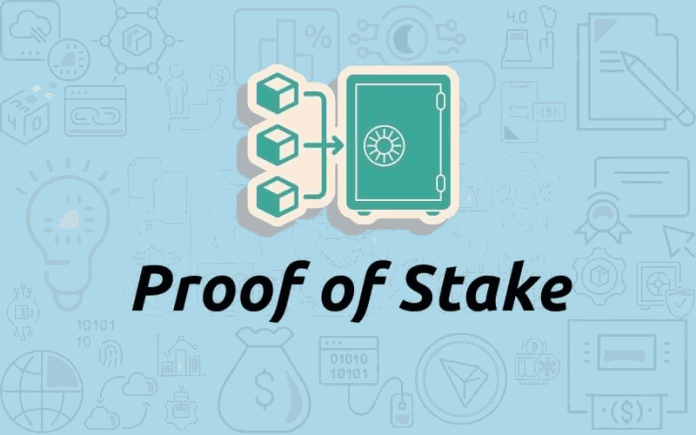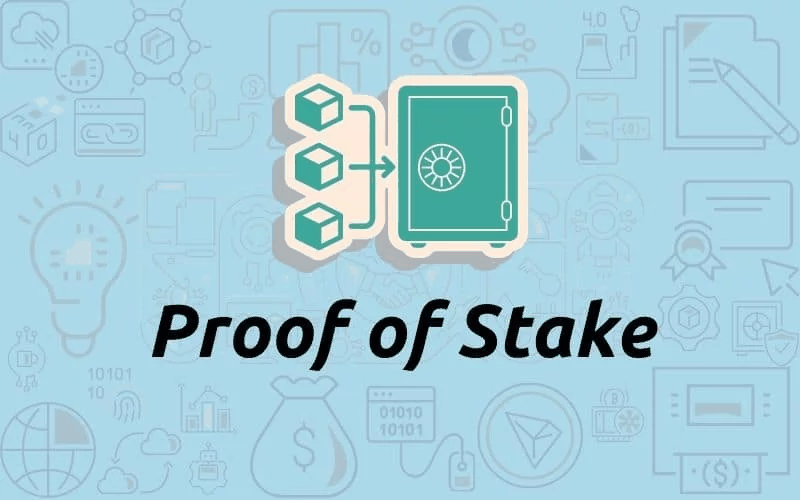
Proof of Stake (PoS) represents a pivotal consensus algorithm within the realm of Blockchain technology, wherein users stake a predetermined quantity of assets to attain the status of Validators in the Blockchain network. As the domain of cryptocurrencies unfolds, two primary methods for reaping the rewards while engaging with the network emerge mining and staking. Mining involves verifying transactions and incorporating them into the Blockchain, whereas staking is more straightforward, merely necessitating the possession of coins to uphold the network. Each approach boasts its distinctive merits and drawbacks; however, staking has recently garnered widespread adoption due to its energy efficiency and reduced barriers to entry.
In this article, we shall delve profoundly into the essence of Proof of Stake (PoS), unearthing its foundational principles, as well as meticulously assessing its pros and cons. We aim to bestow upon you a comprehensive comprehension of Proof of Stake, thereby empowering you to make informed decisions within the dynamic landscape of cryptocurrencies.
Without further ado, let us embark on a profound exploration of Proof of Stake, wherein its intrinsic virtues intertwine with the quest for a more sustainable and accessible blockchain ecosystem.
The Purpose of Proof of Stake
Proof of Stake (PoS) was introduced to address concerns about the sustainability of the environment surrounding Proof of Work (PoW) and its scalability.
In PoW, miners earn Bitcoin by verifying transactions and adding blocks to the Blockchain. However, they incur operational costs such as electricity and rent expenses.
Miners have exchanged energy for cryptocurrencies, but this dynamic has profoundly affected the PoW market in terms of price and profitability.
Furthermore, PoW mining consumes electricity equivalent to that of a small country.
Proof of Stake was conceived to mitigate these issues and provide a more sustainable and scalable alternative to PoW.
What is Proof of Stake?
Proof of Stake (PoS) represents a consensus algorithm utilized in Blockchain technology, allowing users to earn rewards by validating blocks on the Blockchain. In its essence, PoS requires users to stake a certain amount of assets, which grants them the privilege of becoming Validators responsible for confirming transactions within the Blockchain.
In contrast to the Proof of Work (PoW) algorithm employed by Bitcoin, PoS eliminates the need for expensive mining hardware or high electricity consumption. Instead, the PoS network selects Validators based on the number of coins they possess. The more coins staked, the higher the likelihood of being chosen as a Validator, hence the term “Proof of Stake.”
These Validators play a crucial role in verifying transactions on the network and appending them to the Blockchain by providing evidence in the form of a new block. As a reward for their service, Validators receive incentives, either in the form of newly created coins through inflation or transaction fees collected. However, if they make mistakes or act maliciously, Validators face penalties, which may lead to partial or complete loss of their staked assets.
For instance: the Terra Blockchain necessitates users to stake their LUNA tokens to become Validators. In return for their contribution to the network, they are rewarded with transaction fees, which can be paid in various tokens like UST, KRT, or LUNA.
To sum up, Proof of Stake introduces a more sustainable and resource-efficient approach than traditional Proof of Work algorithms. By leveraging the economic stake of users, PoS ensures the security and validation of transactions on the Blockchain, making it an increasingly popular consensus mechanism in the cryptocurrency space.
Characteristics of Proof of Stake
Advantages
Proof of Stake (PoS) presents several compelling advantages:
- Minimal Hardware Requirements: Unlike the resource-intensive mining process of Proof of Work (PoW), PoS operates efficiently on standard computing equipment or virtual servers, making it accessible to a broader range of participants.
- Delegation Capability: PoS introduces delegation, allowing users to delegate their stake to Validators, granting them additional voting power. This delegation process enables users to earn rewards passively without direct involvement in the validation process.
- Scalability and Swift Transactions: PoS significantly improves the network’s scalability and transaction speed by enabling validation from any user staking tokens. This distributed approach fosters a more inclusive and fast-paced ecosystem.
- Environmentally Conscious: PoS stands out for its eco-friendliness, as it eliminates the energy-intensive mining operations seen in PoW-based cryptocurrencies like Bitcoin. PoS contributes to a greener, more sustainable blockchain environment by reducing electricity consumption.
Disadvantages
However, it is essential to acknowledge some of the challenges that PoS faces:
- Token Lockup Period: Upon delegation or becoming a Validator, users often face a token lockup period, extending from a few days to several weeks. This illiquidity might impact users’ ability to respond promptly to market changes.
- Centralization Risks: PoS networks’ governance is influenced by token holdings, giving those with significant stakes a stronger voice. This concentration of power raises concerns about centralization, potentially leading to network control by a select few.
- Security Considerations: PoS networks are susceptible to 51% of attacks, wherein malicious actors gain majority control over the network by owning a significant portion of the tokens. Additionally, Validators may misuse their authority, undermining the network’s integrity.
- Complex System Setup: Implementing a PoS system necessitates substantial coordination among stakeholders, introducing complexities and potential delays in deployment.
While PoS brings several benefits, it also confronts these inherent challenges that must be diligently addressed. As the blockchain landscape evolves, we can expect innovative solutions to mitigate these drawbacks and fortify the PoS ecosystem.
How Proof of Stake Works
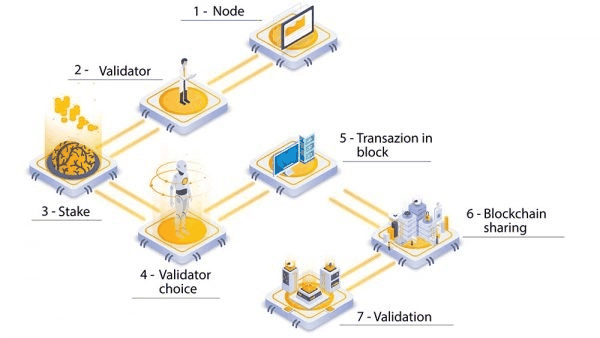
With PoS, users can validate transactions to earn rewards instead of mining new tokens. The reward amount is proportional to the number of tokens the user holds. This means that those who hold more tokens will have a greater incentive to validate transactions, as they can earn more rewards.
These rewards can come from token inflation (pre-defined in the token allocation or unlimited, as seen in Ethereum 1.0, Mina Protocol, etc.). Others use transaction fees, as mentioned in Terra’s case.
There are various ways to implement PoS, but one common method is “Delegated Proof of Stake” (DPoS). In DPoS, users vote for validators responsible for verifying transactions and committing them to the Blockchain. Validators are rewarded with transaction fees and need to hold a certain amount of tokens to qualify for their position.
This system is designed to prevent centralization, as the community chooses the validators rather than being appointed by a single entity. It also means that users can earn rewards even if they do not hold many tokens, as they can delegate their voting power to a validator.
Currently, staking is not limited to blockchains; regular projects are also adopting it to reduce circulating supply and selling pressure. In return, users who lock their tokens will receive project tokens as rewards.

However this approach is currently widely adopted, but it’s a double-edged sword:
- If the project performs well during the lock-up period and proves why users should hold onto their tokens and not sell, there will be no selling pressure after the lock-up cycle.
- On the contrary, if nothing changes during this period, users are likely to dump all the rewarded tokens along with the original ones, causing more significant losses to the project.
Comparison between Proof of Stake (PoS) and Proof of Work (PoW)
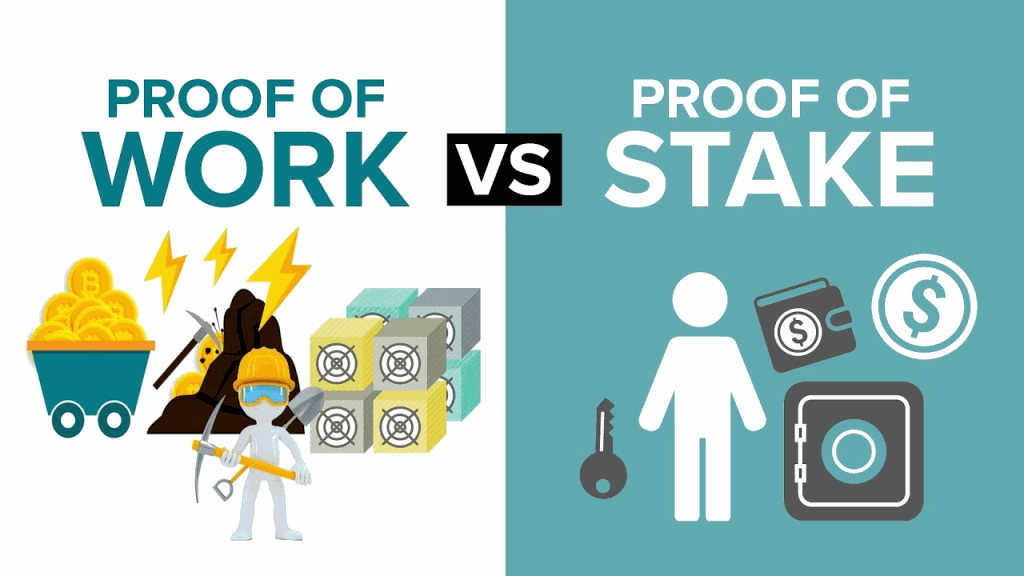
Proof of Stake (PoS) and Proof of Work (PoW) differ in key aspects, including associated costs and the level of control they give transaction validators.
Firstly, let’s briefly touch upon Proof of Work. PoW involves miners confirming the accuracy of transactions across the Blockchain by expending real-world resources (such as mining hardware, electricity, and time). Bitcoin is the most well-known cryptocurrency that utilizes Proof of Work.
Despite being a pioneer in the cryptocurrency space, Bitcoin is often criticized for its association with environmentally unfriendly energy consumption, expensive mining equipment, and complex infrastructure.
However, Proof of Work is still maintained due to its high level of security. The high cost of becoming a miner acts as a deterrent against malicious attacks on the network.
Thus, the differences between Proof of Stake and Proof of Work can be summarized as follows:
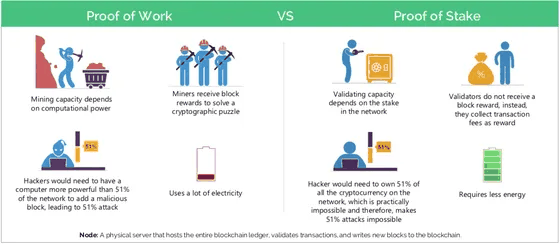
Furthermore, Proof of Work provides almost complete control over which transactions are included in new blocks to those with the most hashing power or computational ability. In contrast, Proof of Stake allows participants to validate blocks by locking up a certain amount of cryptocurrency as collateral. Therefore, validators are incentivized to act in the network’s best interests, as their “investment” is at risk if they don’t.
Lastly, Proof-of-Work often relies on competitive markets to continuously create and improve new mining hardware. This can lead to wasteful expenditure on redundant or overly specialized devices, as miners must spend money to maintain their operations continuously. Such an arms race is absent in Proof-of-Stake, meaning validators won’t waste as much energy or resources to secure transactions.
Overall, each consensus mechanism has its strengths and weaknesses, and its suitability depends on the specific goals and requirements of the blockchain network. As the industry continues to evolve, new innovative approaches may emerge to address the limitations of both Proof of Stake and Proof of Work.
Is Proof of Stake Safe?
Proof of Stake itself is a secure consensus mechanism, but its safety largely depends on the underlying blockchain project.
When participating in a legitimate project, staking tokens can be a rewarding experience, allowing users to contribute to the project’s development without needing technical expertise.
However, choosing a low-quality or poorly secured project is risky. In such cases, the tokens staked could be at risk of loss or significant depreciation.
To ensure the safety of staking, conducting thorough research on the project’s fundamentals, team members, security measures, and community support is crucial. Reputable and well-established projects are more likely to provide a safe staking environment, offering participants rewards and benefits while maintaining their assets’ integrity.
Staking can be a profitable and efficient way to support blockchain networks, but like any investment, it requires caution and discernment. By carefully selecting projects and staying informed about their progress and security practices, participants can minimize risks and make informed decisions to safeguard their investments.
How to Mine PoS Coins?
To mine PoS coins, users need to follow these 5 steps:
- Step 1: Purchase a certain amount of the desired PoS coin. The simplest way is to buy from reputable exchanges such as Binance, Huobi,…
- Step 2: Download the wallet for the specific coin and synchronize it with the computer. During synchronization, the computer must remain continuously connected to the internet, and the time required for synchronization varies depending on the coin.
- Step 3: After the synchronization is complete, users can start staking by running the wallet continuously 24/24. A Virtual Private Server (VPS) for staking is recommended to save hardware costs, electricity expenses, and installation space.
- Step 4: After staking the coins in the wallet for a certain period, the coins will mature and begin competing to create blocks. Users receive rewards directly into their wallets when a block is successfully created.
- Step 5: When users no longer want to stake or mine PoS coins, they can transfer the coins from the wallet to the exchange and sell them.
As mentioned earlier, PoS is a mining form involving staking coins as shares. The number of coins users can mine depends on the number of coins they hold and the staking percentage % allowed by the coin’s development team.
For instance: Coin Buzz offers an annual rate of 1200%, EMB 7200%, and B3 10000%.
However, mining PoS coins is not as simple as depositing coins into the wallet and letting them run 24/24 to earn huge profits. To achieve the highest returns, users need to have a high Weight to compete with other stakes. Weight is determined by the age of the coins and the amount of coins staked. The older the coins and the higher the staking amount, the higher the Weight.
What is Weight in PoS Mining? How to Achieve High Weight in PoS Mining?
Weight (or coin weight in PoS) is determined by the age of the coins and the number of coins being staked. The age of the coins refers to the time it takes for the coins to mature after being deposited into the wallet (usually taking a few hours to several days, depending on the coin).
Once the coins have matured, the Weight will increase. A higher Weight means a higher likelihood of successfully mining a block. However, in the initial period, it may take a long time to mine PoS coins due to the following reasons:
- Users can only mine one block in the first mined block after having enough Weight. However, the rewards from this block will be distributed across several subsequent blocks.
- After approximately 1-2 weeks, the income will start stabilizing as the net weight of the network is formed.
- During the staking process, it is crucial NOT to add or withdraw coins. These actions will reset the efforts to build the net weight network, and users will have to wait for it to be rebuilt.
Thus, achieving a high Weight in PoS mining requires patience and the willingness to commit coins to the staking process without making any additional transactions. Users can increase their chances of successfully mining blocks and earning rewards by allowing the coins to mature and consistently staking them over time.
Proof of stake cryptocurrencies
In the ever-growing world of cryptocurrencies, there is an expanding list of those that use PoS as a consensus mechanism, including the following:
- Avalanche (AVAX): Avalanche aims to help enable the development of dApps (decentralized applications) and was created in September 2020.
- Cardano (ADA): Cardano provides smart contract capabilities and was founded in 2015 by the co-founder of Ethereum, Charles Hoskinson.
- Cosmos (ATOM): Cosmos was created by the Interchain Foundation (ICF) in 2014 to build an open-source blockchain technology.
- EOS (EOS): EOS has its own Blockchain that was first publicly released in January 2018 with the aim of accelerating smart contracts.
- Ethereum (ETH): Ethereum is one of the most widely owned and used cryptocurrencies and moved to PoS in September 2022.
- Peercoin (PPC): Peercoin claims to have been the first to implement the PoS approach and got its start in 2012.
- Solana (SOL): Solana launched in 2017 and aims to be an efficient platform for transaction processing.
Conclusion
Proof of Stake (PoS) is a consensus algorithm used in Blockchain, allowing users to earn rewards by validating blocks on the Blockchain. PoS enhances scalability, transaction speed, and decentralization while being eco-friendly and accessible to users with lower hardware requirements. With Proof of Stake, anyone can earn rewards by participating in staking.


